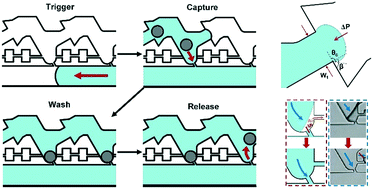A microfluidic device enabling deterministic single cell trapping and release†
Abstract
Successful single-cell isolation is a pivotal technique for subsequent biological and chemical analysis of single cells. Although significant advances have been made in single-cell isolation and analysis techniques, most passive microfluidic devices cannot deterministically release trapped cells for further analysis. In this paper, we present a novel microfluidic device that can achieve high-efficiency cell trapping, which can then be released in a deterministic order. The device contains an array of trapping sites, a main channel, a trigger channel, and an air channel. Two types of capillary valves are configured along the channels. As these capillary valves can be automatically opened in a predefined pattern, the incoming cells can be spontaneously and sequentially trapped into separate trapping sites. After trapping, the individual trapped cells can be released from their sites in a last-trapped-first-released manner by applying pressure from the trigger channel to counteract against the pressure from the main channel. The theoretical model of the trapping and release flow field is established respectively to describe the conditions required for trapping and release. Experiments using MCF-7 cells demonstrated the capability of our device for deterministic single cell trapping and release. We envision that our method constitutes a useful sample preparation platform for single cell analysis.



 Please wait while we load your content...
Please wait while we load your content...